HistorySmith & Wesson released ".38 Hand Ejector" revolver in 1899. It morphed into "Victory Model" during WWII, then to "Military&Police", and finally became "Model 10". In all its incarnations this is probably the most widely produced revolver, with over 6 million pieces out there over the years.
S&W M10 is available in a variety of barrel lengths, from 2 to 6 inches.
Wikipedia information about this revolver:
http://en.wikipedia.org/wiki/Smith_%26_Wesson_Model_10More information:
http://world.guns.ru/handguns/hg76-e.htmModelgunYup, modelgun makers love revolvers, and S&W M10 has been released in many variants over the time. Metal, ABS, HW and FexHW from Kokusai, HW from Hartford...
You can find some information here:
http://homepage3.nifty.com/nkoinuma/SWDAR1.htmI have a Kokusai M10, FBI variant (3" barrel), made of HW. It was the second modelgun I've bought. The first was MGC Colt 1911, then I wanted to have a sample of revolver modelgun, too. M10 won a selection as it was small, HW, fairly cheap and perhaps the most easily available. I enjoyed it a lot after I got it, even as I am not that much into revolvers.
Original thread that describes why I have chosen M10 model:
https://mp40modelguns.forumotion.net/modelgun-general-discussion-f1/kokusai-revolver-m10-fbi-or-m36-chief-special-t913.htmBoxRevolver arrived in an orange box with large "M10" and various other markings on top: "HW Heavy Weight", "NEW CONCEPT MODEL GUN", as well as Kokusai logo and JASG sticker certifying it as a safe plastic toy (similar to SPG). Side of the box bears original price and a bit more details about what's inside: "No.250 S&W M10 3 i-nn-chi FBI mo-de-ru".
Box looks a bit as if it were made in a hurry in a graphic program, with very large fonts and shadow effect on HW letters.

Top of the box is made of carton, bottom part is styrofoam with cutouts for the content.
Inside there was a manual (common for M10 and M19), box of 6 .38 Special cartridges, grip extension and revolver itself. I also purchased real wood grips made Mulberry Field, as they are much nicer than plastic ones.

Manual is fairly simple - exploded diagram and parts list inside, list of versions, simple loading and cleaning instructions, names of revolver parts on front page. Enough for a revolver, as there is no need to disassemble slide or do other complicated things for cleaning - a clear advantage.

 Modelgun
ModelgunRevolver is very solid and nicely heavy, black. HW has a shiny surface finish, looking metal-like.


Barrel in this model is 3 inches long, it's open, only with a usual metal tab inserted through all length except for 1cm near muzzle. Left side is marked "SMITH & WESSON", right "38 S.&W. SPECIAL CTG." Ejector rod is under the barrel, latching onto spring-loaded plunger at the front.
You can note all different colours here: barrel is dark grey (HW), ejector rod is sort of yellow-brownish (metal) while swing-arm is dark brown (metal).

Right side of the frame has more markings: stylized "KS" logo, similar to S&W one with "TRADE" and "MARK" words, behind the cylinder. Logo is accompanied by "KOKUSAI INC. CO.". Under cylinder you will find "MADE OF 1984.3", "MARCAS REGISTRADAS", "SMITH & WESSON", "SPRINGFIELD,MASS."


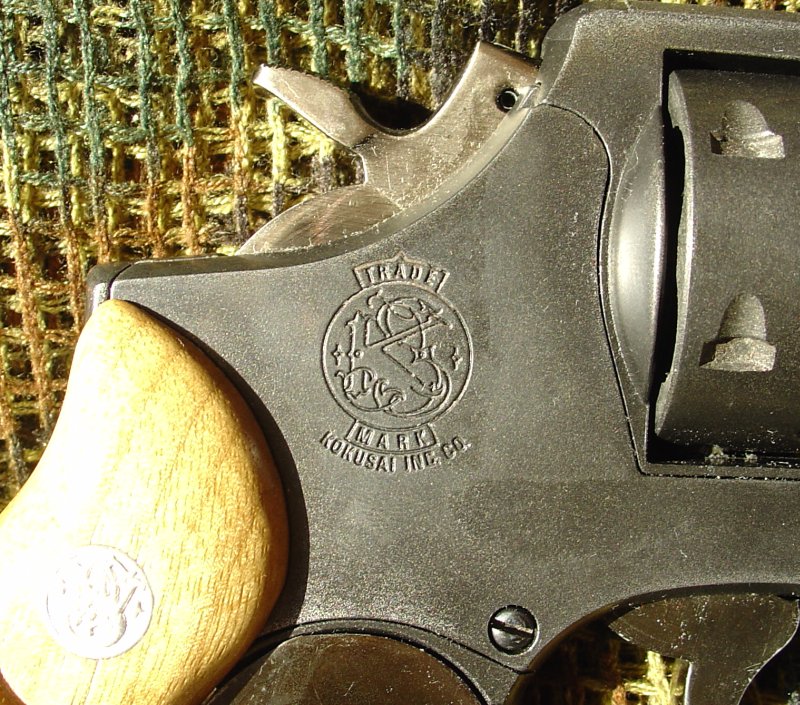

At the top of the frame you will find a blade front sight (fixed) and a groove acting as the rear sight.

Barrel is open, with a usual metal tab running through almost all length. Rear part is where most of residue will be left - you can see uncleaned white "powder" in one of pictures. Similar white residue will accumulate around this area on frame and cylinder.
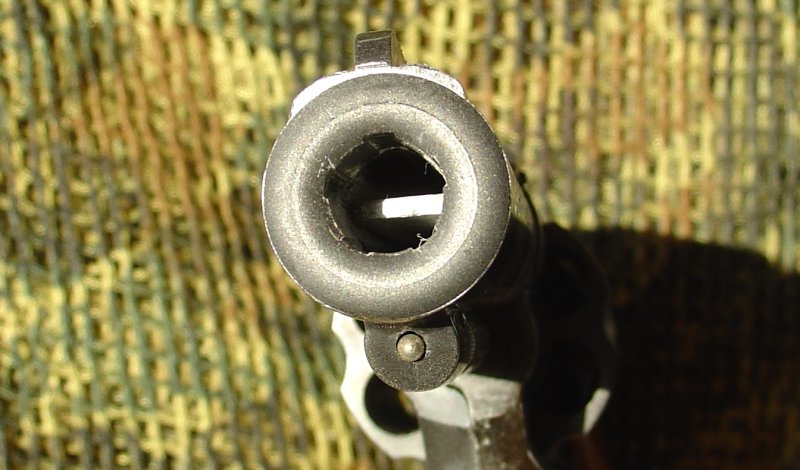

Back wall of the frame, behind cylinder, features mechanism to rotate (inside a vertical slot) and to lock (lug at the bottom of frame) the cylinder, as well as a hole (top one) through which firing pin hits cartridges.
Trigger sits in its guard. Pull is heavy - in a positive way. Trigger works very good and reliably.
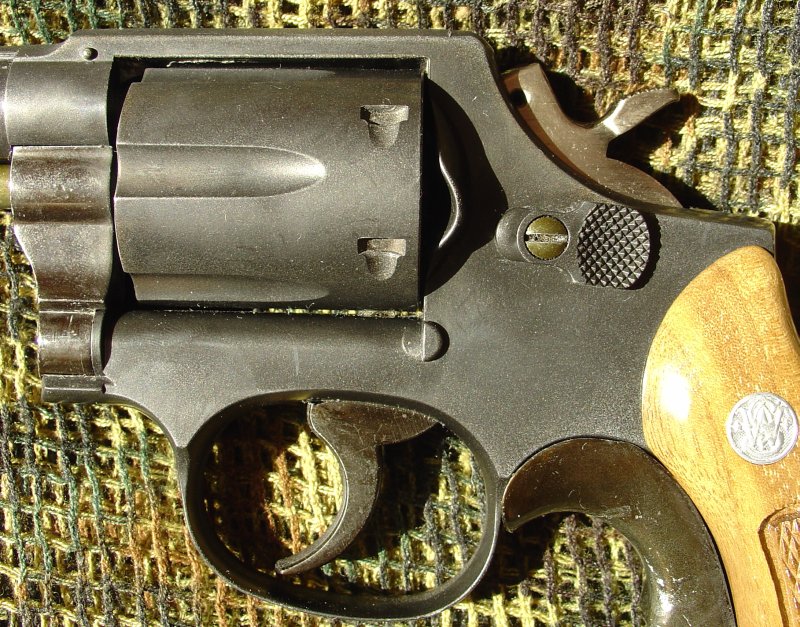
Kokusai grips are dark brown, made of plastic. They have an inlaid medallion with S&W logo. Logo has black background with silver lettering. Grips are held together by a single screw.
Mulberry Field grips are much lighter. They also have the same logo, but it is uniform silver, looking worse in my opinion. Grips are not 100% match in shape.
Revolver is equipped with a grip extender. Original grip is very thin, and I find this model very difficult to hold in hand, not to mention attempting to fire it. Extender can be slid under the grips, from the front, after slightly unscrewing them, then screwing back on. It makes grip a bit larger, partially filling gap between trigger guard and grip. more convenient, but I still can't say this is as good as pistol grips.



Hammer sits where it should, above the grip and behind the cylinder. It is made of several parts - one large piece of metal with a groove, and a firing pin installed on a pivot. There is also a tiny spring behind firing pin, making it return to lower position. Firing pin enters a hole in the frame, reaching bottom of the cartridge, pushing insert and cap onto the detonator pin in the head.
If you look at the hammer from the top it should immediately become clear why this is going to fail quickly. Walls on sides of the pin are thick, thicker than pin itself. Wall behind the pin is thin, just about a hair's width! When hammer falls, firing pin pushes against cartridge, but it also pushes back against the wall. Soon it starts to bulge and eventually breaks. Bulge means that firing pin does not go forward far enough and does not detonate caps.
Firing pin itself is fragile - just a piece of metal that is hammered with every shot, distorting it.


My M10 worked perfectly for less than 100 shots, than started to fire more and more erratically, and finally stopped detonating cartridges at all. At that point hammer (just this tiny wall behind the firing pin) and firing pin itself are damaged and require a replacement. If only pin were bent, it would be cheap and easy to replace, but you need to replace the whole assembly.



Original hammer was black, the one I got as a replacement is silver on the sides, making for a different look.
MagazineIt's a revolver, so instead of a magazine it has a cylinder. It is half-open, just a part is covered by a metal insert.
Cylinder swings out to the left. To open it push forward button on the left side, behind the cylinder, and push cylinder out to the left. You can now load it with cartridges, one by one, or using a speedloader.
Unloading of fired cartridges is made easier thanks to an ejector rod. Open cylinder, push ejector rod, it should lift backs of the cartridges to make it easier to remove them. Somehow I am not very skilled here, I always get cartridges blocking, falling off the ejector part and travelling all around.
Capacity is 6 cartridges.


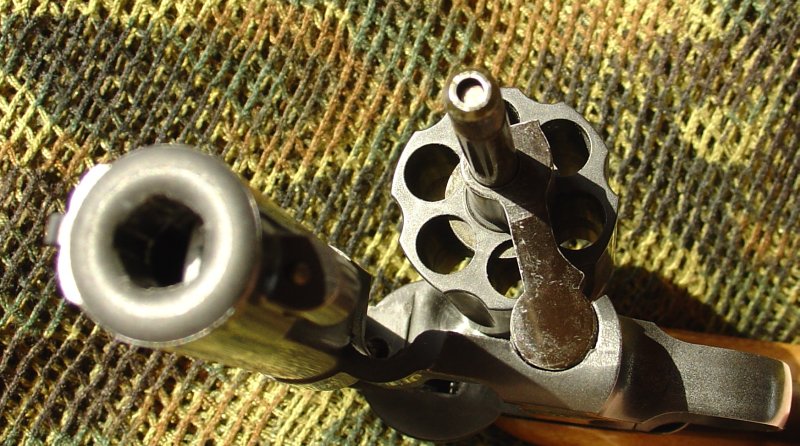


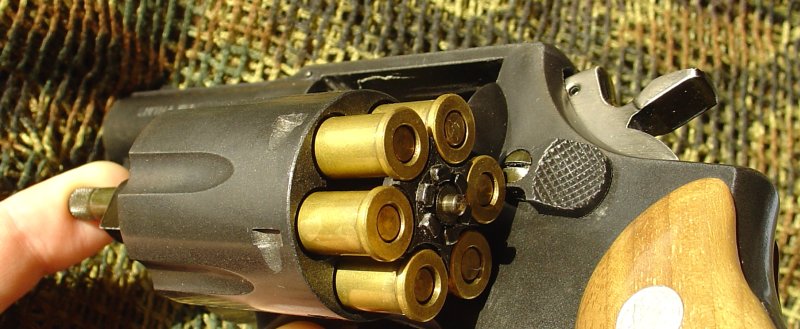 Cartridges
CartridgesThis model uses .38 Special cartridges with Kokusai design. As the cylinder nor barrel do not have detonator pin, it is now integrated in the head of cartridge.
Cartridge is made of three pieces. Bottom is a cylinder with a hole through it. You put there an insert, and place 7mm cap on top. Top part (bullet head) screws onto that, it has a detonator pin going inside cartridge, and a hole through it to let the gases escape.
Real look type cartridges have top part that is copper-coloured, bottom is yellow brass. After some use colour becomes uniform yellow, as the top part oxides and loses it's reddish tint.
Clearing the hole in top part is difficult (use a thin pin) and necessary for revolver to operate correctly - you don't want pressure to stay inside cartridge.
Dry your cartridges after cleaning, otherwise they develop sort of water deposits or discolorations, as you can see in the pictures.


 Firing
FiringPure fun!
Load cartridges, insert them into cylinder and...
...this is single/double action revolver, so you can either pull the trigger all the way, or cock hammer manually and then pull the trigger a short way just to release it.
BANG! BANG! BANG! BANG! BANG! BANG! it's loud!
Revolver fires very well - thanks to no blowback and very short open barrel there is a lot coming out of the front! I would estimate that flame reaches about 5..10cm, visible even in daylight. For even better effects try dusk or night. Marushin caps have more sparks, so they're better in this application.
Nice feature of a revolver is that it just doesn't jam. If a cartridge doesn't fire - keep pulling trigger to fire the next one. You can also rotate cylinder to try and fire the same cartridge again. Shots are succesfull regardless of cap pressure, even if you have a weaker cap, shot is still good!
After firing remember to clean thoroughly cartridges, cylinder, barrel, and frame around barrel. Caps leave residue that will be seen as white deposit, making revolver look not as good as it could.
ProblemsThis is a very good revolver, but there is one weak point: hammer and firing pin design. They are bound for self-destruction way sooner than you could expect. This can be relatively easily replaced.
I think that internal mechanism could wear out eventually, but so far nothing suggests that.
Make sure that revolver fits your hand, it's not too small or too big. For me most revolvers that I like (the small ones) grips are not thick enough. Holding is ok, but pulling trigger is a bit difficult (it's too close to grip).
Basic disassemblyUnscrew single screw that holds grips, remove them.
Unscrew three screws on the right side (one was hidden under grip panel).
Remove side plate and cylinder with swing-arm.
Now you have access to the mechanism - take picture what it looks like, so if you forget how it goes together you have a reference. Pay attention to all springing pieces!
Maintenance, such as replacing hammer, is fairly easy.
OverallThis is a great revolver which is fun to handle and fire. Plenty of smoke and sparks thanks to short open barrel, nice weight and good mechanism make for a satisfying handling.
The only downside is hammer/firing pin design that will require regular replacement.
